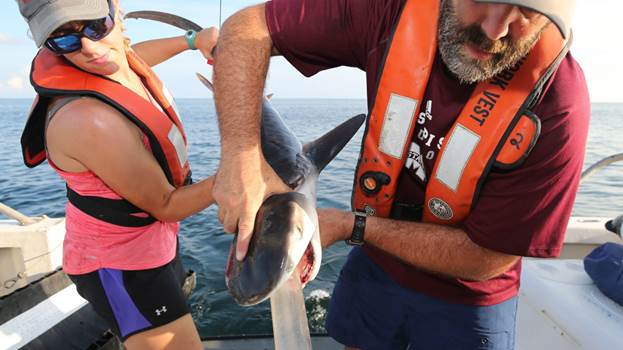
Researchers pump the stomachs of juvenile tiger sharks. The sharks are released. © photos courtesy Marcus Drymon
By Matthew L Miller
Director of science communications for The Nature Conservancy
The house wren or kingbird outside your window right now might one day end up in the stomach of a baby tiger shark. If that seems highly improbable, well, think again.
It’s well known among backyard birders that hawks have taken advantage of the bounty to be found at backyard feeders. In fact, some hawk species have become more urban. Where there’s an abundance of prey, predators will congregate.
A new study published in the journal Ecology found that baby sharks do indeed feed on songbirds. And this isn’t just a one-time freak occurrence. The evidence suggests that sharks actually target terrestrial songbirds.
Here is what’s going on.
It started with a routine fisheries survey in the Gulf of Mexico. Marcus Drymon, a marine fisheries researcher for Mississippi State University, was sampling fishes using long lines. The researchers had just pulled in a small tiger shark and were in the process of weighing and measuring it. The shark regurgitated, a not-unusual occurrence during the stress of capture. But its stomach contents caught the researcher’s attention.
“It barfed up feathers,” said Drymon, lead author of the paper. “I assumed it was from a sea bird like a pelican, gull or cormorant. I thought I could identify them at the lab using a bird feather ID book. It was a lot more difficult than I thought.”
Drymon sent the feathers to friend and frequent collaborator Kevin Feldheim, a geneticist with the Field Museum. His lab analyzed the DNA of the partially-digested feathers.
According to the Field Museum’s report on the findings:
“The scientists took tiny pieces of the bird remains and used chemicals to break them down into their basic molecular components. From there, they were able to examine the DNA sequences present in the bird tissues and compared them to databases of bird DNA to see what species they were from.”
Feldheim, like Drymon, thought the feathers would come from seabirds. After all, tiger sharks have been documented targeting baby albatrosses off Hawaii, and fish like giant trevally will focus on baby sooty terns that fall from their cliff nests into the water.
But the feathers in this shark were not from a seabird.
“It was a brown thrasher,” said Feldheim. “A songbird.”
Drymon and his team began pumping the stomachs of all the young tiger sharks they caught. And they found more feathers. In fact, of 105 sharks studied, 41 had feathers in their stomachs. Some could be identified morphologically, but the rest were sent to Feldheim’s lab for identification.
“None were seabirds,” said Feldheim. “There was one American coot, a marsh species. The rest were songbirds. We found doves, swallows, an Eastern kingbird, a yellowthroat. These were species most people associate with their backyards, not as shark food.”
“We hypothesized that young tiger sharks were focusing on areas where they could feed on songbirds, but we didn’t know the mechanism for how this was happening,” said Drymon.
Literally billions of songbirds migrate across the Gulf of Mexico each year, a long and perilous journey. Tiger sharks were congregating along migration routes. One nearby community – Dauphin Island, Alabama — even advertises itself as “America’s Birdiest Coastal Town.”
“If even a tiny fraction of the birds don’t make the migration, it still represents a lot of food,” said Drymon. “We hypothesize that young tiger sharks congregate in areas to take advantage of this. Unexpected weather patterns and unexpected storms force songbirds into the water.”
“Unlike seabirds, these birds are not well equipped to take off once they end up in the ocean,” said Feldheim.
Adult tiger sharks will eat “pretty much anything they want,” according to Drymon, including sea turtles. But baby tiger sharks, about a meter long at birth, mainly scavenge. Songbirds on the water present a perfect source of protein.
There’s not evidence that other shark species key in on this bounty. In part, it’s because tiger sharks are such opportunists and in part due to feeding habits.
“Tiger sharks often feed closer to the surface than other species,” said Drymon. “I think the birds are likely dead when the sharks feed on them. But they are likely floating or just starting to sink.”
Birders and scientists alike know that many birds don’t complete their migratory journey across the Gulf of Mexico. But whatever becomes of the birds that fall into the ocean? Now we know: many become shark food.
“Those feathers we found in shark barf didn’t represent an isolated occurrence,” said Drymon. “Songbirds are not an insignificant food source for young tiger sharks. We believe the sharks are in areas where birds are more likely to fall.”




